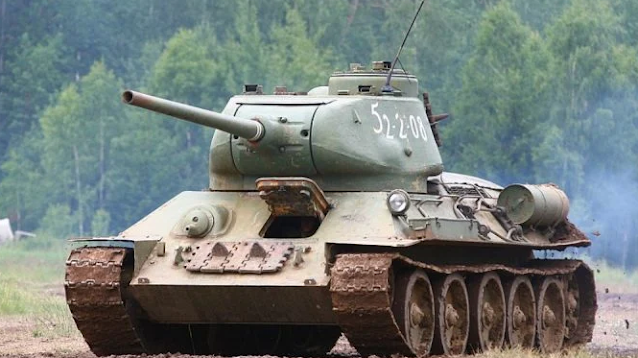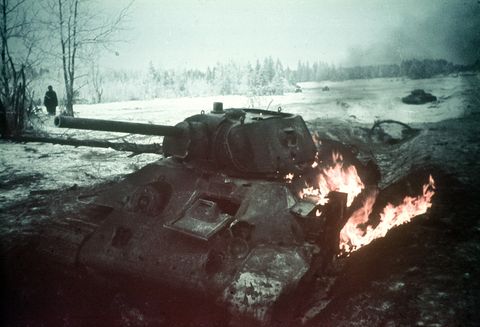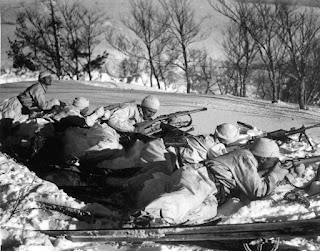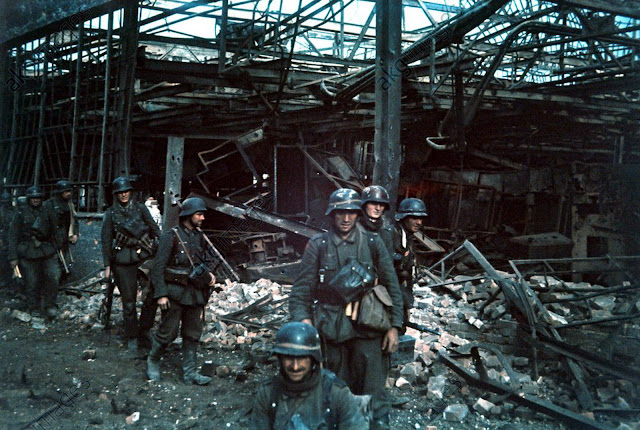Newbie Do - Rules Deep Dive VBM Combat
For my next rules deep dive I wanted to look into another one of those sometimes misunderstood sections and look at VBM (Vehicle Bypass Movement) combat. Not 'what to do to stop it' or the 'best ways to deal with VBM' but instead with the various options once that tank (I will say tank but this also includes other, usually more vulnerable, vehicles) moves in.
Example One
So let us paint the scene. We have a German 1st line 4-6-7 squad with a Heavy Machine Gun and an 9-1 officer sitting in a wood covering a large area of ground that the Russian opposition wants to get past without facing that nasty fire from that unit. The Russian opponent does not have many spare resources to deal with this but does have a T-34 that he could use to VBM freeze the squad.
The tank has used 6 movement points up to this point. He drives it up, stops outside the hex taking 9 MP he stops for 10MP and shoots his machine guns for a 6 up 1 shot (rolls 8 so 'just' misses an effect roll) he then starts for 11MP, passing the mechanical reliability roll with a '4' (the German player doesn’t see the point of leaving residual by shooting at the tank as there is no infantry close so declines to fire - if he 'did' fire then he would be marked with a first fire counter and as that halfs the unit firepower it would be a further -1 to his CCV value if the tank moves into VBM Freeze) [A11.5 around the middle]) and then moves into VBM in the hex for 17 points (note: always try to declare either 'I am using ALL the vehicles remaining movement points' OR 'I am using exactly 6 movement points (in this example), NEVER I am moving into VBM).
It
basically can must be translated into either 'I am staying in hex and
suppressing you by being here' OR ' I am moving through the hex and thus will NOT be
freezing you'
The defending players options are now constrained
by the presence of the scary tank. They can
A - ignore it
B - attack it with close combat reaction fire
Close Combat reaction fire is 'lovely' because
(unlike standard Street Fighting where the squad leaves the location to move to
the Adjacent tank [A11.8]) the Tank does not get to fight back. This tank is not
'brilliant' against infantry but equally is not useless (say hello to Japanese buttoned up light tanks or Stugs) but some tanks carry lots of high power machine
guns that make them very dangerous against infantry so reducing the tanks options to fight back can be useful..
A full squads CCV (Close Combat Value) is 5. If the officer wants to fight WITH the squad (he doesn't have to. He can fight on his own with a 2 factor CCV) then it adds only one to the full squads CCV making 6.
In this example -
Leadership -1 (the officer can only apply his/her leadership modifier when fighting with the squad. You may wonder why he ever would not. Perhaps if he is a 6+1 leader or the vehicle is horribly vulnerable or perhaps the officer will take the tank on while the squad fights some enemy infantry who have just been (very probably) ambushed)
Street Fighting Ambush -1 The units are not
Street Fighting (there is no road) but the rules say that when VBM occurs you
can apply the Street Fighting bonus (think of it as the tank is more capable of
being engaged up close with less risk when it is close to terrain infantry can hide in. This
makes it much more vulnerable). [See last sentence of A11.8]
Motion/Non-Stopped +2 - fighting a moving tank is
much, much harder. Remember this one as it is also one of the key reasons why
you might not want to attack.
They roll an eleven though and fail. The squad and officer are now marked with a CC counter and a First Fire counter. The CC counter merely indicates the squad cannot carry out non-cc reaction fire (if it gets the chance). Since this vehicle is bypass freezing the hex if the squad had not carried out a CC Reaction fire attack then a CC counter gets added at the end of the vehicles movement as well. There is nothing stopping you routing out or deciding to self rout and bug out (if the situation demanded it). The only time you get 'locked' in melee against a tank is if the tank stops or is stopped prior to or during the close combat phase.
Since the tank used more than one movement point to move into VBM the infantry can attack again! They don’t need to pass another PAATC and the only difference is that the first fire marker is a form of halving of firepower so that reduces the CCV by -1 (-1 for each effect applied) Which makes the CCV 5 and the dice roll modifiers cancel each other out as before. Needing 5 now to do something he naturally rolls a 6 and does nothing again. The first fire flips to final fire. Now the German could Final Protective fire a conceivable 4… more times but as each roll would also be a morale check providing just about the same odds as killing the tank the German player declines [D7.2]. The German player has no threat of enemy infantry close by so does not want to take the risk so decides not to continue.
Nothing more now happens until the close combat
phase. Now the above roll is replicated
except there is no ambush (no infantry 'advanced' into Close combat so no ambush had occurred). The tank now potentially gets to fight back. The side
without the tank always goes first so the German would need another 6 to
immobilise and 5 to kill. He roll a 7 and the German player curses his luck.
(note the first/final fire reduction has gone as the marker went at the end of the defensive fire phase)
German Turn
The German infantry want to take the tank out though so they stay. They can shoot at the tank with standard Prep fire (if the tank was an early war model then it might be worth shooting the MG at it. At point blank range the To Kill would be 6) but this tank is immune to that (and deliberate immobilisation is not permitted to machine guns). They cannot reaction fire as that is for the defensive player only so have to stay in hex and soak up (potentially) a triple point blank fire attack from the tank in its defensive fire phase (halved for motion) and very dependant on where the TCA is pointing (so you cannot 'add' your BMG as its covered arc is locked outside of the bypass hex (or behind for a rear BMG). In the close combat phase the infantry and then the tank each get an attack as in the previous turn and both fail to damage the other again.
Russian Turn
In the next turn the Russian player must either make his tank leave the hex (and since this tank is radio less all options require a non-platoon movement check first [D14.23]
- drive into the P2 wood with a bog check
- change VCA towards O3 (permitting a CC Reaction fire attack if another PAATC is successfully passed) and then driving into bypass of P2
- stop and start in reverse movement (needing a mechanical reliability check for this tank) and reverse out to Q4 or change VCA to reverse into bypass of the Q3/Q4 hexside. This has the advantage of keeping the infantry locked down but requires stopping which would permit a CC Reaction Fire attack without motion advantage so being requiring an eight to immobilise or seven or less to kill. Then as many final cc reaction fire and FPF attacks as the German player wants to try
- Stop and start in hex (mechanical reliability roll for this tank needed) spending more points on the start. This has the same reaction fire choice as the previous option.
His best choice therefore he he wants to keep the bypass freeze is to change VCA for 1, enter bypass of P2 for 3 then enter O3 for 5 change VCA 3 times to point towards Q3 for 8 move into P3 for 7 (cost of 1 using 6 delay points) then into bypass of the Q3 wood on the Q3/Q4 hexsides for 17. The Germans would then get either two CC Reaction fire attacks needing 6 to immobilise, 5 or less to kill for the first and 5 to immobilise and 4 or less to kill for the second before a further attack in the CC Phase (6 and 5 again).
This seems the best action to carry out so the Russian player makes his non-platoon movement check and rolls a 10. Ouch. The tank instantly has to stop and spend its remaining movement points as delay points. The German now declares a CC Reaction Fire attack and rolls his PAATC for the squad. With a '5' he passes and now has one attack at 8 to immobilise and 7 or less to kill. This time he rolls an 8 and the tank is immobilised (Note that Rule D5.5 concerning a TC for a crew when their vehicle is immobilized has a specific exclusion for the crew of a vehicle in combat, basically there is little chance of the crew abandoning the vehicle in panic when it is surrounded by angry enemy infantry). The squad is marked with a first fire counter and the German player decides to do a Final Fire CC Reaction fire attack as well. The CCV drops by one due to the first fire counter to 5 but the DRM modifiers also drop by one as the tank is now immobilised. (-1 leader, -1 immobile, -1 street fighting) so as before he need an 8 to do something. He rolls a '12' and the tanks crew use their small arms [A11.621]. The German player rolls random selection and the squad gets casualty reduced. He could carry on with up to 15 FPF attacks but as he now only has a half squad and officer still does not want to take the risk. The infantry therefore end up with a final fire and Close combat counter.
In the close combat phase the infantry again get to attack first. As a half squad their CCV is 3 plus one for the attached officer so '4'. Dice roll modifiers remain at -3 so 7 is required. With a 5 the tank is finally destroyed and does not get to fight back[A11.31] (note that if the non-tank user is,say, splitting his attacks with one unit attacking the tank and one unit attacking some accompanying infantry then he only gets to do one of these attacks before his opponent gets to do one of his. It is not 'all non-tank user attacks' followed by 'all tank user attacks). Since the initial CCV was 4 half of that is 2 and 5 minus the DRM modifiers of 3 is 2 and as 2 is less than or equal to the CCV the vehicle also is now a burning wreck. [A11.5 middle]
Though the Russian is a tank down it has stopped the heavy machine gun and negative leader applying force for a full turn and a half and now the tank is a burning wreck the hex is also filled with smoke (with attending risk of the wreck blaze spreading to the wood (environmental conditions permitting). Either way that unit is going to have to move now removing its direct threat for two whole turns.
Let us re-start from the middle of example one except that this time the Russian T34 spends two movement points to move into VBM (as opposed to 'All' its remaining points). Now the German player 'could' do up to two CC Reaction fire attacks if he passes the PAATC (and is another reason the defender wants to know 'exactly' how many movement points are used getting that tank into the hex) with the same odds as before (CCV 6 DRM cancelling each other out). The German player can see that the tank has some movement points left (4) so does not do anything. The Russian tank cannot suddenly now announce he is delaying for 4 and remaining as you have to announce the delay points when announcing the initial movement spend [D2.18]. He could change VCA and move around the hex in bypass (he cannot do so here because if you change VCA as part of bypass movement you have to then enter the next hex in bypass [D2.33]). Stop (perhaps possibly start) which allows delay MP to be spent - this will allow a post successful PAATC CC reaction fire attack of 6 CCV base with -2 dice modifiers so an 8 to immobilise or a 7 or less to kill (great odds) plus other potential cc reaction fire attacks with 5 CCV (-1 for the first fire) and DRMs of -2 (7 and 6 needed). Or simply leave the hex. Unfortunately the simple 'leave' option is weakened by the fact that the only available forward hex is the wood in P2 thus requiring a bog check or to switch to reverse movement and reverse out would firstly involve stopping (and increased risk of death) but the tank also does not have enough MP to stop, start and reverse out to Q4 (he would need 6). ESB is possible for reversing tanks and though it would only need 2 'extra' points would still require stopping and inviting that favourable CC Reaction Fire attack. The Russian was hoping the German would take a first fire shot thus lowering his firepower and lock the Heavy Machine Guns covered arc towards the Bypass hex point so instead changes his VCA towards O3 for a total of 14 then moves into bypass of P2 for a total of 16 with 1 delay point here spent to make 17. The German's held their nerve and are now free to shoot at any Russian infantry and the tank use was wasted.
In this situation the Russian player 'looks' like he is trying to take advantage of a lack of rules knowledge by a less experienced player (if you are a suspicious type of person) as the Russian advantages here are minimal allowing the opponent knows the rules involved.
For another good explanation as to why you should be very specific on VBM entry points spent then please see the excellent article by Peter Struijf in Journal 12 'A dose of antifreeze' (p4-p11 and particularly the sidebar on page 10)
No yet again
A player can not also just say 'I'm remaining in hex' in the following turn. If you are in motion in VBM then you must spend a movement point [D2.4]
You can still do this
Units with effective anti-tank weapons can use normal first/final fire when the tank enters as you can always still shoot at a target in hex. Just remember that VBM target facings are strange and for a unit firing in hex the shot will always hit the side target facing [D2.32 last sentence] so you get the lower of the two armour factors but not the bonus for shooting at the rear (also note the exclusion for MOL/FT/DC in D3.2)
Suppressing this is good. Not certain if the photo is genuine or a reconstruction. I suspect it's genuine but some modern re-enators like 'oldifying' their photos. I wish they wouldn't..















Comments
Post a Comment